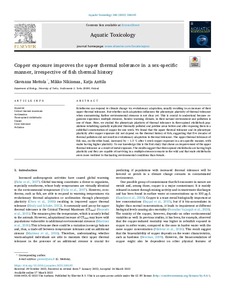Copper exposure improves the upper thermal tolerance in a sex-specific manner, irrespective of fish thermal history
Mottola Giovanna; Nikinmaa Mikko; Anttila Katja
https://urn.fi/URN:NBN:fi-fe2022081154701
Tiivistelmä
Ectotherms can respond to climate change via evolutionary adaptation, usually resulting in an increase of their upper thermal tolerance. But whether such adaptation influences the phenotypic plasticity of thermal tolerance when encountering further environmental stressors is not clear yet. This is crucial to understand because organisms experience multiple stressors, besides warming climate, in their natural environment and pollution is one of those. Here, we studied the phenotypic plasticity of thermal tolerance in three-spined stickleback populations inhabiting spatially replicated thermally polluted and pristine areas before and after exposing them to a sublethal concentration of copper for one week. We found that the upper thermal tolerance and its phenotypic plasticity after copper exposure did not depend on the thermal history of fish, suggesting that five decades of thermal pollution did not result in evolutionary adaptation to thermal tolerance. The upper thermal tolerance of fish was, on the other hand, increased by ∼ 1.5 °C after 1-week copper exposure in a sex-specific manner, with males having higher plasticity. To our knowledge this is the first study that shows an improvement of the upper thermal tolerance as a result of metal exposure. The results suggest that three-spined sticklebacks are having high plasticity and they are capable of surviving in a multiple-stressor scenario in the wild and that male sticklebacks seem more resilient to fluctuating environmental conditions than female.
Kokoelmat
- Rinnakkaistallenteet [27094]
